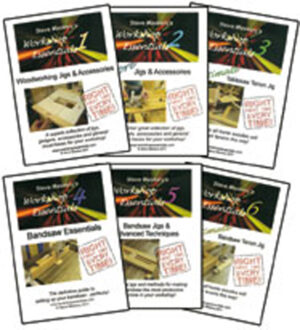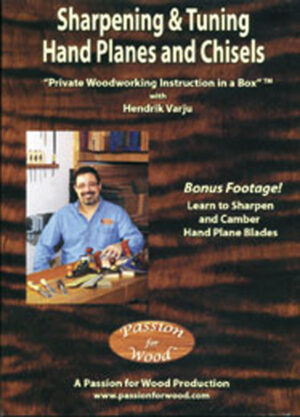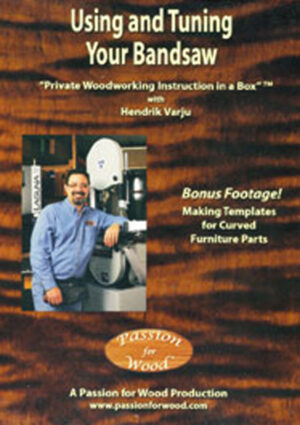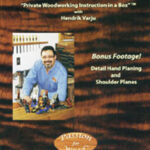HAND PLANING TECHNIQUES DVD
$120.00
Private Woodworking Instruction in a Box
with Hendrik Varju
Produced by Passion for Wood, Ontario, Canada
ISBN 978-0-9881280-1-9
As reviewed in The Australian Woodworker Issue 168
This is the second of two DVDs which Hendrik Varju has produced to cover the preparation and use of handplanes. The first, titled: Sharpening and Tuning Hand Planes and Chisels, was reviewed in the last Issue of The Australian Woodworker.
It was clearly the author/’s intention that the two DVDs should be seen in sequence, but it is equally clear that he recognises some viewers will perhaps not be able, or may simply prefer not to do this. He therefore starts his treatment of Hand Planing Techniques with a brief overview of the most important aspects of handplane preparation and tuning. (For those who have already seen the previous video, these notes will serve as a helpful reminder.)
The revision of hand plane tuning allows Varju to move directly to an examination of cutting angles in both bevel-up and bevel-down planes.
He demonstrates the effectiveness of various cutting angles, emphasising the manner in which the angle influences the ability of a plane to achieve a good result, particularly with difficult woods such as those that exhibit wavy grain. These and other circumstances in which there is a reversal of grain along the path of the plane, give rise to tear-out.
The demonstrations are, in some instances, quite dramatic. For example, he shows that just one stroke of a plane against the grain can cause so much tear-out that it may take 30 or more strokes in the opposite direction in order to clean the surface.
Reading the grain is therefore essential to obtaining a smooth surface on either an edge or the broad face of a board and this is a recurring topic throughout the various sections of this video.
Another recurring topic is the choice of an effective cutting angle of the plane blade to achieve the best surface.
Increasing the effective cutting angle tends to reduce tear-out, but it increases the amount of force necessary to move the plane along the wood as the action of the sharpened edge moves more towards scraping than cutting.
Varju shows that it is relatively easy to increase the effective angle of a bevel-up plane simply by re-grinding the blade. But it is more difficult when using a bevel-down plane.
Since there are likely to be more bevel-down than bevel-up planes in an average workshop, the need to increase the effective cutting angle of a bevel-down plane may well arise.
Varju describes a technique by which a micro-bevel may be ground on the back of such a plane blade. Typically, he says, the angle of this micro-bevel would be about 150 degrees.
When added to the standard Common Pitch of most bevel-down planes, this would achieve an effective cutting angle of 600.
If the plane has a York Pitch (500 degrees), the effective cutting angle would be 650 degrees.
Since the grinding of a micro-bevel may only be carried out to perform a specific task, the manner in which the plane blade might then be returned to its normal configuration is also discussed.
After describing the procedure for setting up first a bevel-down and then a bevel-up plane, Varju demonstrates the tendency of a handplane to cut a convex curve when used to plane an edge. He suggests that many woodworkers are probably unaware of this and shows why it occurs by comparing the cutting action of a hand plane to that of jointer.
To overcome this obvious impediment when edge-jointing boards, Varju carefully demonstrates a method of making sequential ‘stop-cuts’ that ensure a perfectly straight edge.
After this, he covers the planing of an edge so that it is exactly square to the wide surface of a board.
The next major topic (it absorbs an entire disk!) is the planing of panels such as table tops.
First, there is a demonstration of how to determine the degree of flatness of the panel. The high areas are marked and careful planing begins, keeping in mind which one of the several distinct planing techniques that are shown, should be used to accommodate the grain which the plane encounters.
The next disk (#4), contains instructions for levelling solid and iron-on edgebanding, flattening a mitred frame or door frame and levelling end-grain. The latter is discussed with special reference to common tasks such as dovetails and finger joints, the demonstration pieces being either partially made or completed drawers.
The fifth and final disk provides some ‘bonus footage’.
This begins with several small jobs such as planing chamfers and corner splines as well as the ends of dowels.
The next and final section is a detailed examination of the shoulder plane, its sharpening, set-up and use. This tool was omitted from the previous DVD on sharpening and setting up hand planes. It is dealt with here in the same manner as the other planes – everything from complete disassembly, through to final sharpening.
Hendrik Varju now has a well-established audience in many parts of the world, including Australia. This is hardly surprising. All of his DVD presentations including the one reviewed here, offer extraordinarily detailed instruction in a casual manner that makes information easy to assimilate.
The teaching methods employed are obviously those which Varju has been using for years in the classes he takes in his workshop.
Every session begins with all the necessary tools assembled, with demonstration pieces ready to be lifted onto the bench and with paper sheets hanging on an easel waiting for him to illustrate each point as it is made.
The run-time of the five disks in Hand Planing Techniques is an unhurried 10 hours and 29 minutes but viewers are unlikely to want the time to go faster.
Duration: 10hrs, 29mins, 5 discs
DVD – English – NTSC







